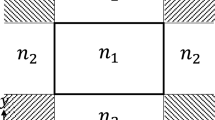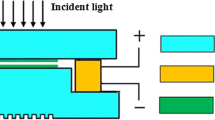Abstract
A new technique is proposed for improving the coupling efficiency of vertical multimode interference couplers. The technique replaces conventional multimode waveguides with multilayer waveguides (MLWs) in the design of these couplers. The separation between the high refractive index layers of the MLWs is modulated to fit the propagation constants of their guided modes to the ideal parabolic profile required for perfect coupling. Numerical computations of the proposed couplers demonstrate the ability to transfer 86 % of optical power between 220-nm thick SOI waveguides at a vertical separation of 2.3 μm.





Similar content being viewed by others
Notes
As T/π increases the gap thickness decreases to conserve the number of modes; see Ramadan (2014) and references therein for details.
References
Abolghasem, P., Han, J.-B., Kang, D., Bijlani, B.J., Helmy, A.S.: Monolithic photonics using second-order nonlinearities in multilayer-core Bragg reflection waveguides. IEEE J. Sel. Top. Quantum Electron. 18, 812–825 (2012)
Antoniou, A., Lu, W.S.: Practical Optimization: Algorithms and Engineering Applications. Springer, Berlin (2007)
Burden, R.L., Faires, J.D.: Numerical Analysis. Brooks/Cole, Boston (1997)
Chaisakul, P., Marris-Morini, D., Isella, G., Chrastina, D., Rouifed, M.-S., Roux, X.L., Edmond, S., Cassan, E., Coudevylle, J.-R., Vivien, L.: 10-Gb/s Ge/SiGe multiple quantum-well waveguide photodetector. IEEE Photon. Technol. Lett. 23, 1430–1432 (2011)
Gandomkar, M., Ahmadi, V.: Design and analysis of enhanced second harmonic generation in AlGaAs/AlOx microring waveguide. Opt. Express 19, 9408–9418 (2011)
Huang, J.Z., Scarmozzino, R., Osgood Jr, R.M.: A new design approach to large input/output-number multimode interference couplers and its application to low-crosstalk WDM routers. IEEE Photon. Technol. Lett. 10, 1292–1293 (1998)
Jouane, Y., Chang, Y.-C., Zhang, D., Luo, J., Jen, A.K.-Y., Enami, Y.: Unprecedented highest electro-optic coefficient of 226 pm/V for electro-optic polymer/TiO2 multilayer slot waveguide modulators. Opt. Express 22, 27725–27732 (2014)
Kireev, A.N., Graf, T.: Vector coupled-mode theory of dielectric waveguides. J. Lightwave Technol. 39, 866–873 (2003)
Kishioka, K., Hashimoto, M.: Coupling of guided light through a periodic multilayer. Appl. Opt. 21, 320–323 (1982)
Osman, N., Koshiba, M., Kaji, R.: A comprehensive analysis of multilayer channel waveguides. J. Lightwave Technol. 12, 821–826 (1994)
Ramadan, T.A.: Analog-to-digital optical waveguide conversion at sampling periods greater than the free-space wavelength. J. Opt. Soc. Am. A: 31, 35–40 (2014)
Saini, M., Sharma, E.K.: Equivalent refractive index of MQW waveguides. IEEE J. Quantum Electron. 32, 1383–1390 (1996)
Soldano, L.B., Pennings, E.C.M.: Optical multi-mode interference devices based on self-imaging: principles and applications. J. Lightwave Technol. 13, 615–627 (1995)
Srivastava, T., Jha, R., Das, R.: High-performance bimetallic SPR sensor based on periodic-multilayer-waveguides. IEEE Photon. Technol. Lett. 23, 1448–1450 (2011)
Tsang, S.H., Yu, S.F., Yang, H.Y., Liang, H.K., Li, X.: ZnO–ZnMgO multiple quantum-well ridge waveguide lasers. IEEE Photon. Technol. Lett. 21, 1624–1626 (2009)
Ulrich, R., Kamiya, T.: Resolution of self-images in planar optical waveguides. J. Opt. Soc. Am. 68, 583–592 (1978)
Vassallo, C.: About coupled-mode theories for dielectric waveguides. J. Lightwave Technol. 6, 294–303 (1988)
Yin, X., Zhang, T., Chen, L., Li, X.: Ultra-compact TE-pass polarizer with graphene multilayer embedded in a silicon slot waveguide. Opt. Lett. 40, 1733–1736 (2015)
Author information
Authors and Affiliations
Corresponding author
Appendices
Appendix A: Computations of the matrices \(\bar{\bar{A}}\) and \(\bar{\bar{P}}\)
The elements of the Jacobian matrix \(\bar{\bar{A}}\) are, \(A_{mk} = {{\left( {\left. {\beta_{m} } \right|_{{\bar{S}_{o} + u\bar{\delta }_{k} }} - \beta_{om} } \right)} \mathord{\left/ {\vphantom {{\left( {\left. {\beta_{m} } \right|_{{\bar{S}_{o} + u\bar{\delta }_{k} }} - \beta_{om} } \right)} u}} \right. \kern-0pt} u}\), where β m and β om are the mth elements of \(\bar{\beta }\) and \(\bar{\beta }_{o}\), respectively, while \(\bar{\delta }_{k}\) is the vector whose ith element, δ ki , is the Kronecker delta. The numerator of A mk is the change in the modal propagation constant, β m , due to a change u in the kth element of the normalized separation vector, \(\bar{S}_{o}\); keeping all other elements unchanged. It is computed by numerically solving the exact dispersion relation of the MLW. Initially, \(u = \hat{S} - {\check{S}}\), which is the maximum change in the normalized separation between the HRI layers of the MLW. Here, \(\hat{S}\) and \({\check{S}}\) are the maximum and minimum normalized separation of the uniform array of HRI layers (unmodulated MLW) which support the same number of modes as the modulated MLW. See Ramadan (2014) and references therein for details.
The matrix, \(\bar{\bar{P}} \equiv \left[ {\Delta \bar{{\check{S}}}^{\left( 1 \right)} \Delta \bar{\hat{S}}^{(1)} \;\;\Delta \bar{{\check{S}}}^{\left( 2 \right)} \Delta \bar{\hat{S}}^{\left( 2 \right)} \ldots \;\;\Delta \bar{{\check{S}}}^{\left( M \right)} \Delta \bar{\hat{S}}^{\left( M \right)} } \right]\). Its columns \(\Delta \bar{\hat{S}}^{\left( m \right)}\) and \(\Delta \bar{{\check{S}}}^{\left( m \right)}\) are the vectors which induce maximum \(\Delta \hat{\beta }_{m}\) and minimum \(\Delta {\check{\beta}}_{m}\) changes in the propagation constant of the mth guided mode, respectively. The kth elements of these vectors, \(\Delta \hat{S}_{k}^{\left( m \right)}\) and \(\Delta {\check{S}}_{k}^{\left( m \right)}\), are identified by testing the sign of the Jacobian matrix element, A mk . If it is positive\negative, then \(\Delta \hat{S}_{k}^{\left( m \right)} = u\backslash 0\) and \(\Delta {\check{S}}_{k}^{\left( m \right)} = 0\backslash u\), where u and 0 represent the maximum and minimum normalized separation modulation steps, respectively. The change in normalized separation, \(\Delta \bar{S} = \bar{\bar{P}} \bar{\alpha }\). The elements of the modulation vector, \(\bar{\alpha }\), satisfy the conditions, α j ∊ [0, 1] and \(\sum\nolimits_{j = 1}^{2M} {\alpha_{j} = 1} \;\;\;\;\forall j \in \left\{ {1,2, \ldots , 2M} \right\}\), to ensure that the elements of \(\Delta \bar{S}\) are all limited between 0 and u. This limitation conserves the number of guided modes during modulation.
Appendix B: Converting the fitting error f to a quadratic function of \(\bar{\alpha }\)
The optimum values of \(\epsilon\) and ɛ which minimize the fitting error f are found by solving a standard linear regression problem (Burden and Faires 1997). They are given by,
and
Here, α om and α em are the elements of modulation vector \(\bar{\alpha }\) which multiply the odd and even columns of the matrix \(\bar{\bar{P}}\) corresponding to the mth mode. The parameters, μ, \(\overset{\lower0.5em\hbox{$\smash{\scriptscriptstyle\smile}$}}{\sigma }_{m}\), and \(\hat{\sigma }_{m}\) are the sums, \(\sum\nolimits_{i = 1}^{M} {\beta_{oi} } ,\sum\nolimits_{i = 1}^{M} {\Delta {\check{\beta}}_{i}^{\left( m \right)} }\), and \(\sum\nolimits_{i = 1}^{M} {\Delta \hat{\beta }_{i}^{\left( m \right)} }\), respectively. The parameters, γ, \({\check{\rho}}_{m}\), and \(\hat{\rho }_{m}\) are the weighted sums, \(\sum\nolimits_{i = 1}^{M} {i^{2} \beta_{oi} } ,\sum\nolimits_{i = 1}^{M} {i^{2}\Delta {\check{\beta}}_{i}^{\left( m \right)} }\), and \(\sum\nolimits_{i = 1}^{M} {i^{2}\Delta \hat\beta_{i}^{\left( m \right)} }\), respectively. The functions, Z M (x, y) ≡ (18xM 2 + 18xM − 6x − 30y)/(8 M 3 + 3 M 2 − 11 M) and Y M (x, y) ≡ (60xM 2 + 90xM + 30x − 180y)/(16 M 5 + 30 M 4 − 5 M 3 − 30 M 2 − 11 M). Substituting with these optimum modal profile parameters back into f and carrying out few algebraic steps results in the following quadratic function of \(\bar{\alpha }\),
Here, \(\bar{\bar{Q}}\) is an M × 2 M matrix whose columns are the vectors \(\bar{{\check{Q}}}^{\left( m \right)}\) and \(\bar{\hat{Q}}^{\left( m \right)}\) while \(\bar{q}\) is an M × 1 vector. The ith elements of \(\bar{{\check{Q}}}^{\left( m \right)}\), \(\bar{\hat{Q}}^{\left( m \right)}\), and \(\bar{q}\) are \({\check{Q}}_{i}^{\left( m \right)} = \Delta {\check{\beta}}_{i}^{\left( m \right)} +\,i^{2} Y_{M} \left( {\overset{\lower0.5em\hbox{$\smash{\scriptscriptstyle\smile}$}}{\sigma }_{m} ,{{\check{\rho}}}_{m} } \right) - Z_{M} \left( {\overset{\lower0.5em\hbox{$\smash{\scriptscriptstyle\smile}$}}{\sigma }_{m} ,{{\check{\rho}}}_{m} } \right),\;\hat{Q}_{i}^{\left( m \right)} =\Delta \hat{\beta }_{i}^{\left( m \right)} + i^{2} Y_{M} \left( {\hat{\sigma }_{m} ,\hat{\rho }_{m} } \right) - Z_{M} \left( {\hat{\sigma }_{m} ,\hat{\rho }_{m} } \right)\), and q i = Z M (μ, γ) − i 2 Y M (μ, γ) − β oi , respectively.
Appendix C: Reduction of the fitting error, f, by iteration
The linear approximation of A mk in “Computations of the matrices \(\bar{\bar{A}}\) and \(\bar{\bar{P}}\) ” in the Appendix leads to an error floor which adds up to the error in the QP optimization algorithm. In practice, if the algorithm converges correctly, then most of the error is due to this floor which sets a bound on the computational accuracy of the proposed method. In order to get below this bound, we need to get a better estimation of the Jacobian matrix \(\bar{\bar{A}}\) by computing its elements as local derivatives of modal propagation constants in the vicinity of the QP solution point, \(\bar{\tilde{S}}\); as opposed to linearizing these derivatives across the entire modulation space. This better estimation of \(\bar{\bar{A}}\) is computed by first getting \(\bar{\tilde{S}}^{*}\) which is a better estimation of \(\bar{\tilde{S}}\) through,
where \(\overline{{\Delta \tilde{S}}} = \bar{\tilde{S}}^{*} - \bar{\tilde{S}}\) and \(\overline{{\Delta \tilde{\beta }}} = \overline{\tilde{\beta}} - \overline{\beta_{id}}\). Equation (8) is reduced to a least-square problem that is solved for \(\overline{{\Delta \hat{S}}}\) using QP optimization under the constraints, \({\check{S}} - \tilde{S}_{k} \le\Delta \tilde{S}_{k} \le \hat{S} - \tilde{S}_{k} ,\;\;\forall k \in \left\{ {1,2, \ldots , N - 1} \right\}\). This solution gives a better estimation of the normalized separation vector, \(\bar{\tilde{S}}^{*}\), and the propagation constant vector, \(\bar{\tilde{\beta }}^{*}\). Then, a better estimation, \(\bar{\bar{A}}^{*}\), of the Jacobian matrix is computed after replacing \(\bar{S}_{o}\) by \(\bar{\tilde{S}}^{*}\), \(\bar{\beta }_{o}\) by \(\bar{\tilde{\beta }}^{*}\), and u by an infinitesimally small quantity, i.e. \(A_{mk}^{*} = {{\left( {\left. {\beta_{m} } \right|_{{\bar{\tilde{S}}^{*} + u\bar{\delta }_{k} }} - \tilde{\beta }_{m}^{*} } \right)} \mathord{\left/ {\vphantom {{\left( {\left. {\beta_{m} } \right|_{{\bar{\hat{S}}^{*} + u\bar{\delta }_{k} }} - \tilde{\beta }_{m}^{*} } \right)} u}} \right. \kern-0pt} u}\). With the generation of each new Jacobian matrix, the whole optimization process described in Sect. 3 is repeated. This repetition results in iterative computations that use the solution of the QP optimization in Sect. 3 plus the single-step correction in (8) to get a better solution, which minimizes the error in propagation constant, r β . During this iteration, all parameters are recalculated including the optimum spectral profile parameters \(\tilde{\epsilon }\) and \(\tilde{\varepsilon }\) in (5) and (6). The successive update of the normalized separation vector and the reduction in u around this vector (which improves the linearity approximation in (3)) are the essence behind the expected improvement in accuracy with successive iterations; which is verified through the numerical examples in Sects. 4 and 5.
Rights and permissions
About this article
Cite this article
Ramadan, T.A. Modal spectrum engineering of multilayer optical waveguides: towards digital vertical multimode interference couplers. Opt Quant Electron 48, 191 (2016). https://doi.org/10.1007/s11082-016-0469-2
Received:
Accepted:
Published:
DOI: https://doi.org/10.1007/s11082-016-0469-2




